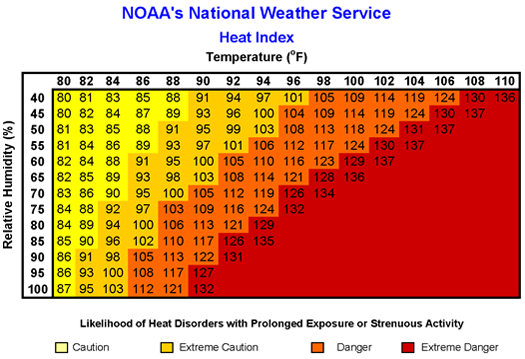6 Ways to Improve Your Construction Company's Profitability
Improve your construction company's profitability with these tips from improving productivity to estimating for profit and tracking and analyzing...

Are you doing everything you can to minimize your workers’ exposure to heat-related illnesses? Does your company have a heat illness prevention program in place? We’ve got you covered with these tips and guidelines for keeping your workers safe and productive during these hot summer days.
Training should be provided to all employees and supervisors working in high temperatures for an extended amount of time. Topics covered in the training should include how heat can affect the body, how to identify the signs and symptoms of various heat illnesses, and what steps to take if a worker is experiencing symptoms of a heat-related illness or if they observe a coworker with symptoms.
Stress to employees the importance of getting plenty of water, shade, and rest especially on days when the temperatures are higher than normal or when they are doing tasks that put them at a higher risk of suffering a heat-related illness. Explain to workers that in addition to the heat and humidity, certain work environments like roofing or roadwork, sun exposure, and body heat created by physical exertion can all lead to heat-related illnesses.
An ample supply of cool drinking water should be provided and easily accessible for all employees on the construction site. The general rule of thumb is a quart of water per employee per hour during their shift. Remind workers they should not wait until they are thirsty. Drinking small amounts on a frequent basis is best.
If workers want additional drinks at the construction site, encourage them to bring something that contains electrolytes, like coconut water or sports drinks, to replenish what is lost while sweating.
As a general rule, once the temperatures start hitting 80° F shade from the sun should be provided for workers during breaks and rest periods. Full shade is needed for workers to be able to cool off. Examples include tents, air-conditioned site trailers or vehicles or ventilated buildings. Workers should be encouraged to rest and cool off in shaded areas throughout the day. Shaded areas should be easily accessible especially in the event a worker begins having symptoms of heat illness and needs assistance in getting out of the sun.
Workers need to get acclimatized to working in hotter temperatures. It can take anywhere from a few days to a couple of weeks for workers to fully adapt to the heat. Once your body gets fully acclimatized to the heat you will begin sweating earlier and at a faster rate and the sweat will contain lesser amounts of sodium. All of this allows your body to retain more water and cool you better. Acclimatization will also improve blood flow and reduce your heart rate when working in high temperatures.
Intense activity should be limited during the first few days of acclimatization. Workloads should be gradually increased each day as the body gets used to the strenuous work in the heat. It is important to monitor workers during this process as they are at a higher risk of suffering heat illness before their bodies get adapted to the heat.

As the heat index rises during the day, so does the risk level for workers to suffer a heat illness. Supervisors and safety managers should monitor the forecast for each day so that the proper protective measures can be implemented. The heat index is a combination of air temperature and relative humidity and is used to how hot it actually feels outside.
OSHA has a free Heat Safety Tool app for iPhone and Android. Instead of manually having to enter both the temperature and humidity, the app can automatically pull the weather data for your current location from the National Oceanic and Atmospheric Administration (NOAA) and calculate the heat index and risk level along with necessary precautions to take. The app lets you choose between the current data or the highs forecast for the day, or you can to manually enter both the temperature and the humidity to calculate the heat index.
Workers should be monitored frequently throughout the day to ensure that they aren’t showing any signs or symptoms of heat illness. This can be as simple as verbally communicating with all workers to more advanced measures such as checking an employee’s heart rate, temperature, blood pressure, and water loss. Workers should be responsible for self-monitoring as well and should report any symptoms to a supervisor immediately. Pairing workers up on the buddy system is also a great way to keep an extra eye on all your workers.
Workers should be made aware that personal risk factors can make them more susceptible to heat illness. These include age, overall health, level of acclimatization, alcohol consumption, prescription drugs, and the amount of water consumed throughout the day.
Symptoms of heat exhaustion include headache; dizziness; weakness; cold, pale, or clammy skin; fast or weak pulse; nausea or vomiting, and fainting. Not all of these symptoms will necessarily be present if suffering from heat exhaustion.
Symptoms of heatstroke include high body temperature (above 103°F); hot, red, dry or moist skin; difficulty breathing; confusion; seizure; heavy sweating; rapid and strong pulse and possible unconsciousness. Heatstroke is the most serious of the two main types of heat illness. Heatstroke can cause major damage to the brain, heart, liver, kidneys, and muscles.
OSHA has compiled the following chart of protective measures to take based on the heat index and associated risk level:
| Heat Index | Risk Level | Protective Measures |
|
<91°F
|
If workers must wear heavy protective clothing, perform strenuous activity or work in the direct sun, additional precautions are recommended to protect workers from heat-related illness.* |
|
|
91°F to 103°F
|
Moderate | In addition to the steps listed above:
If workers must wear heavy protective clothing, perform strenuous activity or work in the direct sun, additional precautions are recommended to protect workers from heat-related illness.*
|
| 103°F to 115°F | High | In addition to the steps listed above:
When possible, reschedule activities to a time when heat index is lower |
| >115°F | Very High to Extreme | Reschedule nonessential activity for days with a reduced heat index or to a time when the heat index is lower
Move essential work tasks to the coolest part of the work shift; consider earlier start times, split shifts, or evening and night shifts. Strenuous work tasks and those requiring the use of heavy or non-breathable clothing or impermeable chemical protective clothing should not be conducted when the heat index is at or above 115°F. If essential work must be done, in addition to the steps listed above:
|
*The heat index is a simple tool and a useful guide for employers making decisions about protecting workers in hot weather. It does not account for certain conditions that contribute additional risk, such as physical exertion. Consider taking the steps at the next highest risk level to protect workers from the added risks posed by:
**Under most circumstances, fluid intake should not exceed 6 cups per hour or 12 quarts per day. This makes it particularly important to reduce work rates, reschedule work, or enforce work/rest schedules. |
||
Immediate action should be taken as soon as a worker is observed or reports any signs or symptoms of heat illness. In the event of an emergency, 911 should be called immediately. Workers and supervisors should both be able to give their current location and a description of symptoms to the 911 dispatcher. First aid should be provided to the worker based on their symptoms.
For heat exhaustion or cramps, workers should be moved to a cool, shaded area and be given plenty of cool water to drink. Tight clothing should be loosened and ice packs can be applied until the worker is feeling better. If heat exhaustion doesn’t improve or worsens after an hour of rest, the worker should seek medical attention.
For heat stroke, call 911 immediately and begin to administer first aid. This includes moving to an air-conditioned area where they can lie down and removing any unnecessary clothing. Cool the body by applying ice packs to the worker’s armpits, groin, back, and neck to get their core body temperature down. Alternatives include wetting the skin while fanning air over the body or immersion in cool water or an ice bath.
The key to keeping your workers safe and preventing heat-related illnesses from occurring at your construction site is to have a written heat illness prevention program as part of your company’s overall policy.
Looking for more ways to beat the heat this summer? Check out these tips for keeping cool at the construction site.
Work Smart, Be Safe!
Improve your construction company's profitability with these tips from improving productivity to estimating for profit and tracking and analyzing...
Construction firms are always looking for ways to maximize jobsite productivity. Here are nine areas to focus on to improve construction productivity.
Looking to find construction projects faster? Learn five ways construction project software helps you find opportunities and win more contracts.
Looking for ways to increase productivity in manufacturing? Here are 6 ways to increase productivity at your manufacturing facility.
ConstructConnect empowers construction professionals with data-driven insights, market trends, and expert analysis to help you build smarter and win more work. Our blog covers preconstruction strategies, economic forecasts, tech innovations, and industry best practices. Whether you're a contractor, subcontractor, architect, or supplier, stay informed and competitive with timely, expert content. Explore our latest articles and get the insights you need to stay ahead.